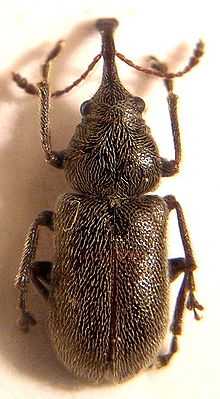Nemonychidae
From Wikipedia, the free encyclopedia
| Nemonychidae | |
|---|---|
 | |
| Doydirhynchus austriacus | |
| Scientific classification | |
| Kingdom: | Animalia |
| Phylum: | Arthropoda |
| Class: | Insecta |
| Order: | Coleoptera |
| Suborder: | Polyphaga |
| Infraorder: | Cucujiformia |
| Superfamily: | Curculionoidea |
| Family: | Nemonychidae |
| Subfamily | |
| |
Nemonychidae is a small family of weevils, placed within the primitive weevil group because they have straight rather than elbowed antennae. They are often called pine flower weevils. As in the Anthribidae, the labrum appears as a separate segment to the clypeus, and the maxillary palps are long and projecting. Nemonychidae have all ventrites free, while Anthribidae have ventrites 1-4 connate or partially fused. Nemonychidae lack lateral carinae on the pronotum, while these are usually present, though may be short, in Anthribidae.
Nemonychidae feed upon the pollen of softwoods such as pine.
| Wikispecies has information related to: Nemonychidae |
Selected genera
- Acromacer
- Atopomacer
- Cimberis
- Lecontellus
- Libanorhinus[1]
- Nemonyx
- Pityomacer
References
- ↑ Cano,R.J., Poinar,H.N., Pieniazek,N.J., Acra,A. and Poinar,G.O. Jr. (1993). Amplification and sequencing of DNA from a 120-135-million-year-old weevil, Nature, 363, 536-538.
This article is issued from Wikipedia. The text is available under the Creative Commons Attribution/Share Alike; additional terms may apply for the media files.